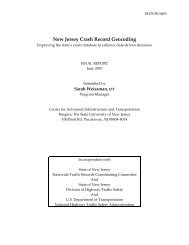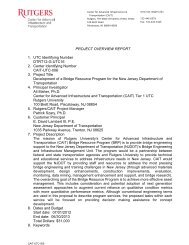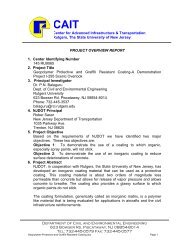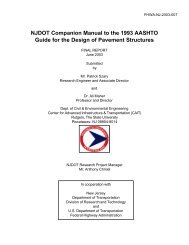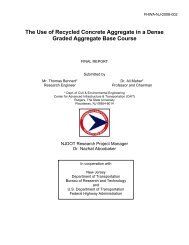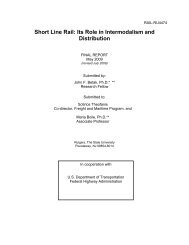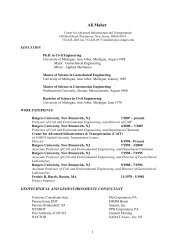ROADSIDE INSPECTION DATA AND CRASH DATA ANALYSIS - CAIT
ROADSIDE INSPECTION DATA AND CRASH DATA ANALYSIS - CAIT
ROADSIDE INSPECTION DATA AND CRASH DATA ANALYSIS - CAIT
Create successful ePaper yourself
Turn your PDF publications into a flip-book with our unique Google optimized e-Paper software.
Roadside inspection and crash data analysiso The chance of losing data at the scene is increased due to other issuesinvolving an accident (towing, legal process, medical care).There is a chance when the vehicle is towed from the crash scene ormedical emergency is needed, some of data needed for accuracypurposes will be missed. For example, the report might not have the finaldiagnosis of injured people after they are taken to the hospital (he/ shemight die at the hospital), or driver/passenger information.o Crash report (NJTR-1 form) is not always submitted by reporting agencieswithin a 5-day period.o Some of the FMCSA required data elements are not in the NJTR1 Form.All FMCSA elements which are the basis for state evaluation are not beinggathered by the NJTR-1. These elements are the license class code,carrier address, intrastate, and interstate. In addition, other data elements,such as carrier and USDOT information, which are part of the collectionprocess, are not properly prepared.o NJTR-1 errors:- Blank fields- Erroneous fields- Mismarked fields- Illegible fields Verification and Analyzing the Process and Datao Crash reports with errors (blank fields, erroneous and unreadable data,etc.) are not sent to the police departments (no feedback).o Data collection and preparation take a long time (from Crash date totransferring to MCMIS).o Inaccuracy of data is increased when data is unreadable by vendor.o If more that 25 percent of data is unreadable in the NJTR-1, report is notadded to the system. (4)o The FMCSA data fields, which are the basis for the NJDOT evaluation bythe FMCSA, need more attention. Accuracy and completeness of theFMCSA elements are being treated as other data elements in theverification process. No extra efforts, priority or check points are observedfor the FMCSA data elements.o ARD system has default values which are not accurate for some of theFMCSA data fields (e.g., carrier name, carrier state).o Required checkpoints for critical fields in SAFETYNET and MCMIS are notenough. All critical data fields (FMCSA data elements) need to be checked13



